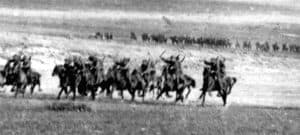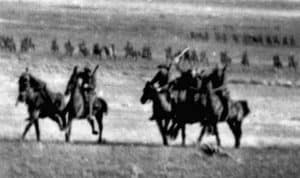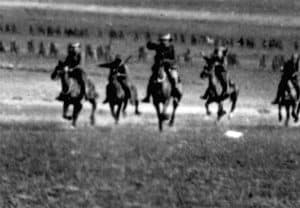BEERSHEBA… THE CONTROVERSIAL PHOTOGRAPH OF THE CHARGE
For nearly sixty years, the authenticity of this photograph has been hotly debated.
It was claimed to show the light horse charge at Beersheba on 31 October 1917. But the photographer was unidentified, the original negative could not be located, and the viewpoint of the charge seemed unlikely. How does a photographer come to be in no man’s land in the path of an actual cavalry charge?
The official view of the Australian War Memorial has been that it was actually taken during a re-enactment of the charge staged for an official cameraman at Belah on the coast of Palestine some five months later – despite the fact that no matching movie film or photograph has ever been produced…
See also…
Beersheba, a genuine photograph of the charge?
Photographs of Australian Light Horse going into action at Beersheba.
Photograph scanned at 300dpi, about 1.5 times original size, uncropped, altered for contrast/brightness
Click on the below enlarged sections of the photograph.
 |
 |
 |
 |
The photograph first appeared as a copied snapshot passed around among light horsemen on the Palestine front in 1918. By December 1920, when an exhibition of war photographs toured Australia under the direction of Donovan Joynt, VC, the Beersheba picture was “a notable exhibit”. Joynt recorded that the photograph was “under constant discussion” and the theory that it actually showed the Belah re-staging had already been advanced. However, this notion was effectively squashed when Brigadier General Grant (who had directed the charge) and members of his staff examined the photo and pronounced that while the landscape in it tallied with that at Beersheba, it did not match the terrain at Belah. Grant also said that the charge was shown in correct formation, finally declaring, “I cannot and will not take exception to the claim made in the Exhibition catalogue that it is a photograph of the actual charge”.
It was apparently also during this tour that someone proposed the idea that the photograph had been taken by a Turk and found in his camera when he was captured. The absurdity of the theory clouded official attitudes to the photograph for the next sixty years and encouraged the Memorial’s acceptance of the “Belah re-enactment” theory. Forty seven years after his first encounter with the photograph, Donovan Joynt sought a print from the Memorial for publication in R. J. Hall’s “he Australian Light Horse”. The then Director, Mr W. R. Lancaster, wrote to Lieutenant Colonel Joynt on 29 May 1967, summarizing the Memorial’s reasons for treating the photograph as not genuine.
1. The formation in which the charge was made was different from that shown in the photograph.
2. At Beersheba the ground was quite bare and the galloping horsemen quickly became enveloped in large clouds of dust. In the photograph the ground appears to be fairly well covered with herbage and there is practically no dust.
3. At Beersheba, the Light Horsemen charged in a westerly direction in the late afternoon so that the shadows would fall behind the horses.
4. The final stretch of the Beersheba gallop was downhill whereas the horsemen in the picture are galloping uphill.
5. There is also the improbability generally of such a photograph having been taken.
Undeterred, Joynt contacted the 4th Light Horse Association to see if veterans of the Palestine campaign could help his research. They could and did. The Assistant Secretary of the Association, E.G. (Rex) Elliott, was introduced as the man who had taken the photograph. Elliott, who completely convinced Joynt that his claim was genuine, wrote a statement which was published in an edited form in “The Australian Light Horse”. This is the complete text of his account.
| I, Eric George Elliott, state that on 31st Oct. 1917 I was a rangefinder with the 4th A.L.H. Brigade which was resting in reserve in a depression between two ridges about four miles east of Beersheba, at approx. 1430 hrs I was called to H.Q. and instructed to accompany a party of officers and take some ranges and prepare range charts, the party moved out to the front on the Brigade position and halted behind a knoll approx. 3,300 Yards from the town of Beersheba. I was given my points to range on by the M. G. (machine-gun) and Artillery officers in the party, this I did and reported the ranges verbally to each officer and noted them on a rough plan from which to prepare my range charts. The officers them moved back to Brigade area and left me to prepare my range charts and deliver them to the respective officers with a copy to Brigade H. Q. I was about half way through this task when I happened to look in the direction of the Brigade area and saw dust rising indicating that there was some movement taking place. I hastened to complete my job under the impression that this was what my charts were required for, at the same time keeping my eye on the Brigade area, to to my surprise it seemed to be within minutes, I saw horsemen in extended order coming over the crest of the ridge, I packed my gear, and then came another line of troops in the same order, I then moved around to the other side of the knoll, and by this time the third line appeared, bewildered by what was happening I just lay there and gazed in astonishment, as the front line drew nearer I saw that their bayonets were drawn and that they were approaching at a hard gallop, having a camera in my haversack I got it out and took a shot, got on my horse and went as fast as I could further out to a flank and then back to H. Q., there I learned that my charts were not now needed as the whole plan had been changed and that an attempt was being made to capture Beersheba with a Cavalry Charge by the 4th and 12th Regts. In Jan 1918 I met a fellow of the 4th A. L. H. Regt. who was returning to Australia, I gave him my spool and asked him to have it developed and sent to my parents, I told him that it had a shot of the charge on Beersheba, and that if it was any good, he could have what copies of it he wanted. On my return to Australia in Feb 1919 my parents gave me prints of photos that had been sent to them posted in Melbourne, this they could not understand, but which I soon explained. One of these prints was to the best of my belief the one I had taken at Beersheba of the charge of the 4th A. L. H. Regiment. I had several enlarged copies made and over the years gave them to members of the Regiment. This print is identical with one now in the hands of L. Col. Joynt of Blackburn. (Signed) E. G. Elliott |
Joynt subsequently sent a copy of the Elliott statement to the Memorial’s Director with a report of Grant’s 1920 opinion on the authenticity of the photograph. Despite this, the official view supporting the Belah theory endured.
I first encountered the photograph about three years later. Now, after some twelve years of sporadic research, I believe that it is undoubtedly genuine. I have carefully considered the objections put forward by the Memorial.
1. As attested by Grant in 1920, the charge formation is accurately depicted. I have spoken with thirteen men who rode in the charge. All considered the formation correct and the photograph genuine.
2. Reports of dust raised by the charge came from men looking into the sun – a situation which exaggerated its density. Men watching from the side, with the sun over their shoulders, could see the action quite clearly. It also seems likely that the combination of reddish brown dust and reddish sunlight minimized the effect of dust in the photograph.
Regarding the “herbage”, a veteran of the action, Vic Smith, commented in 1981 that part of the charge lay over the stubble of a recently harvested Bedouin crop. Untrimmed copies of the photograph show traces of furrows in the foreground.
3. Regarding sun direction, the Light Horsemen did not charge west, as stated, but to the north-west. Also, according to the Curator of Astronomy at the Melbourne Science Museum, Dr Robin Hirst, on that day at Beersheba the sun set sixteen degrees south of west. This placed it more than sixty degrees to the left of the charge, as shown in the photograph.
4. The “uphill” effect in the photograph was created by a slightly tilted camera. With true verticals restored, the formation is heading down a very slight slope.
5. The Elliott statement removed any improbability of the photograph being taken – specifically the improbable Turk. In addition, a road is visible on the right flank of the formation and a wadi can be seen across the front of the second line of horsemen. Both features existed at Beersheba. In 1981 I walked over part of the charge course and photographed the hills south-east of Beersheba. In character and detail, they match those seen in the charge photograph.
One piece of the jigsaw remains to be found – the movie film of the re-enacted charge at Belah. I believe that it lies somewhere in the Australian War Memorial collection and was used as stock footage in the Charles Chauvel epic of 1941,”Forty Thousand Horsemen”. In the heart of the spectacular Beersheba charge sequence is one shot totally out of phase with everything around it – different in the formation of troops, in film quality, and in camera speed. It is a crowded long-shot of three lines of closely packed horsemen at a half-hearted gallop. Nothing could be more unlike the expanse and incredible vitality of the controversial charge photograph.
I can find no reason to doubt that the photograph represents an authentic record of a truly great feat of Australian arms. I believe it is more that time for both the photograph and the man who took it to achieve the recognition they deserve.
Written approximately 1977.
Author not supplied.

